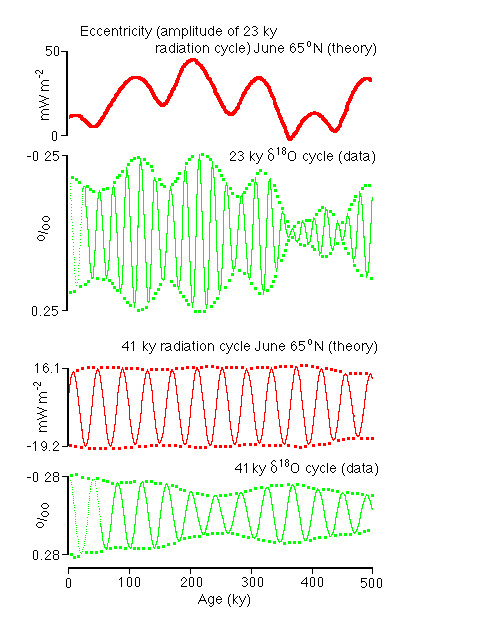
What do we know about Pleistocene climate?
1. Numerous proxies show strong periodicities with periods of 23, 41, and 100 ky (Figure GC-3)
2. The amplitude of proxy peaks at periods of 23 and 41 ky can be explained by linear forcing by precession and tilt of the earth's axis (Figure GC-1, 2) as represented by the level of incoming radiation at 65º N.

Figure GC-1. Variations in the amplitude of ![]() 18O
and radiation cycles
18O
and radiation cycles
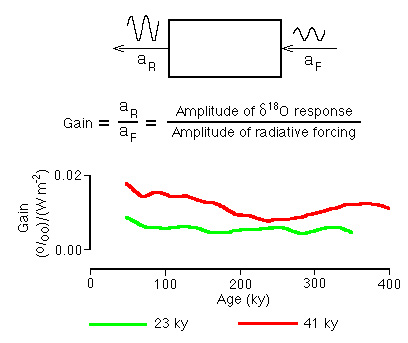
Figure GC-2. Gain in the precession and frequency bands as a
function of time for the past 350-400 ky. The amplitude of incoming
radiation at 65º N is used as forcing and the amplitude of the
![]() 18O
signal in the same bands is used as response.
18O
signal in the same bands is used as response.
3. The significance and magnitude of phase relations between tilt (41 ky period) and proxies are ambiguous because both hemispheres are impacted identically. Because the same lags (due, presumably, to the same processes) also occur in the 23 ky (precession) band in which the radiation effects on the hemispheres are out of phase, however, the initial effects must originate in the northern hemisphere
Table 29-1. Response times relative to northern and southern forcing
|
|
|
|
|
Relative to northern forcing |
|
|
|
|
|
|
|
Relative to southern forcing |
|
|
|
|
|
4. Phase lags between the spectra of different proxies and inferred radiative forcing yield consistent and physically reasonable sequences of oceanographic processes for each glacial-interglacial cycle (Figure 22-7).
An examination of 14 proxies (Figure GC-3) shows that 11 have
similar phase relations in all three frequency bands. They can be
separated into a group that leads ice volume (![]() 18O)
and a group that lags ice volume.
18O)
and a group that lags ice volume.
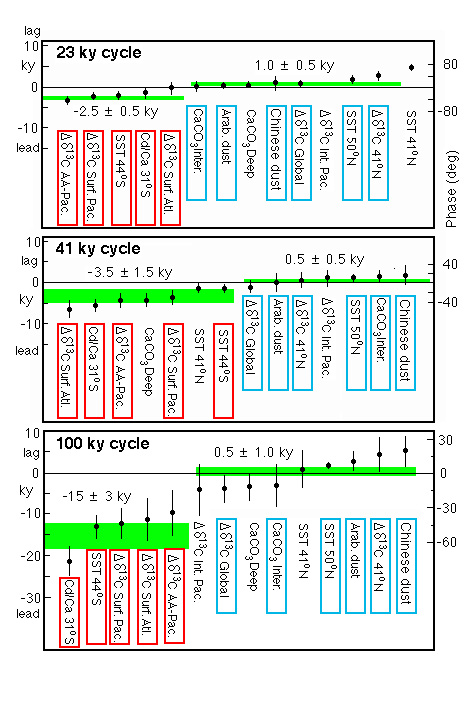
Figure GC-3. Mean lag times and phases for 14 climatic proxies
relative to ![]() 18O
at the Milankovitch orbital frequencies.
18O
at the Milankovitch orbital frequencies.
Proxies that lead ![]() 18O:
18O:
All these proxies are related to the magnitude of the flux of NADW. All would be expected to respond rapidly to events in the Nordic Sea that increase or decrease the rate of formation of NADW.
Proxies that lag ![]() 18O:
18O:
All these proxies are responses to the build-up of significant northern hemisphere ice masses.
In terms of years, the average lag times for both the lead and lag groups are indistinguishable in the 23 ky and 41 ky bands, suggesting that the response mechanisms of the earth's climatic system to forcing are the same at these two frequencies. For the 100 ky band, the average lag is the same, whereas the lead time is about four times as long as for the other two frequencies.
5. Given the striking variations in the flux of NADW, a likely area for initial responses is the Nordic Sea, as defined by Imbrie et al. Because long proxy records suitable for spectral analysis do not exist for this area, the issue must be assessed in the time domain.
Figure GC-4 shows the relations of a number of processes during Termination 1, the conclusion of the last ice age. These events are well dated by 14C.
This is followed by the initial retreat of the margins of the
Laurentide ice sheet which appears to be in phase with the
increase in 16O (i.e. decline in ![]() 18O)
in the world ocean.
18O)
in the world ocean.
This is closely followed by a spike of ![]() 18O
depleted water in the Nordic Sea, which is attributed to the
initiation of massive melting of the northern hemisphere ice
sheets
18O
depleted water in the Nordic Sea, which is attributed to the
initiation of massive melting of the northern hemisphere ice
sheets
This is followed by accelerated retreat of the ice margin and rise in sea level.
Figure GC-4. Evidence that northern hemisphere deglaciation at the end of the last ice age was a response to orbital forcing and that the earliest responses were in the northern Atlantic (Nordic Sea) region.
The frequency and time domain observations can be simulated by a
simple mathematical model. For example, suppose there is a single
forcing (incoming radiation) and a single response (![]() 18O) variable. Then for a system with a delay time d and a
response time T, the phase delay at frequency f is given by:
18O) variable. Then for a system with a delay time d and a
response time T, the phase delay at frequency f is given by:
![]() = 2
= 2![]() fd+arctan(2
fd+arctan(2![]() fT)
fT)
Since there are analogous phase delays in both the 23 and 41 ky bands, the two equations in two unknowns can be solved to yield d of about 1 ky and T of about 17 ky. Both are plausible, given the response times of the ocean and a large continental ice mass.
As discussed earlier, Imbrie et al. conclude that four climatic states are involved in the Pleistocene climatic cycles. They modify the simple mathematical model accordingly (Figure GC-5) to include a single delay time of 1 ky and three response times of 3, 5, and 0.5 ky.
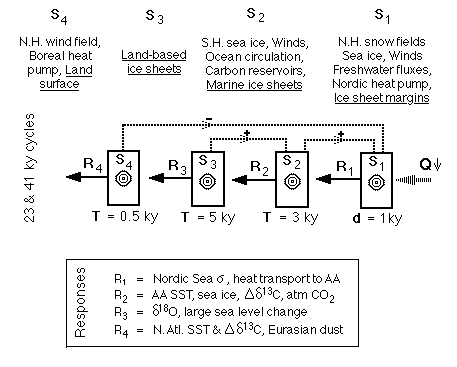
Figure GC-5. Mathematical model of 23 and 41ky responses to radiative forcing at 65º N. Si are linear subsystems (components listed at top of figure) having either delays (d) or time constants (T).
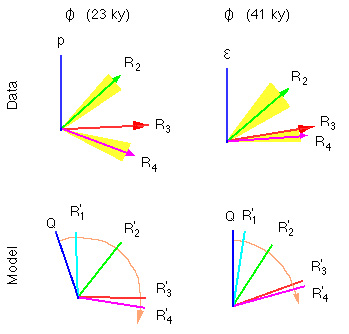
Figure GC-6. The phase clocks show the goodness of fit between the model of Figure GC-5 and data. Note that R1 is not sampled by the available time series, but is inferred from the time domain relationships.
After iteration, the fit between models and data is reasonable, particularly if the date of maximum 65º N radiation is shifted from mid-June to early June or late May.
The 100 ky problem
The simple model developed for the linearly forced precession and tilt frequency bands cannot be applied directly to the eccentricity (100 ky) band. Some of the issues:
1. The forcing generated by eccentricity variations is too weak (Figure GC-7) to produce the responses observed in the terrestrial climate proxies.
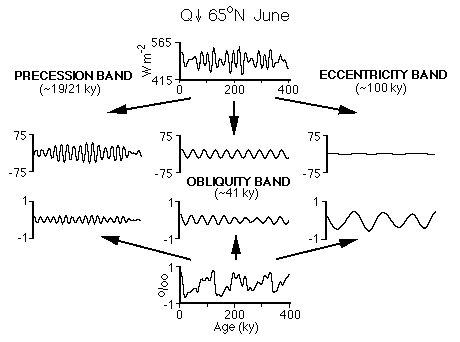
Figure GC-7. Partitioning of incoming 65º N June radiation
and ![]() 18O
(ice volume) record into precession, tilt, and eccentricity bands.
Note the striking discrepancy between the amplitudes of the radiation
and ice volume time series in the 100 ky band.
18O
(ice volume) record into precession, tilt, and eccentricity bands.
Note the striking discrepancy between the amplitudes of the radiation
and ice volume time series in the 100 ky band.
2. The eccentricity record has power at periods of both 100 and 400 ky, whereas the ice volume record only shows 100 ky power. At 100 ky, there is fair agreement between the two signals (Figure GC-8).
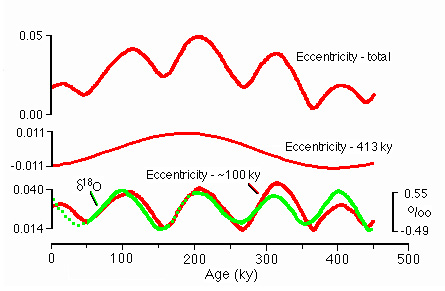
Figure GC-8. Eccentricity showing 100 ky and 400 ky cycles during
the past 500 ky. After removing the 400 ky cycle, the amplitudes of
the eccentricity and 100 ky ![]() 18O
records are quite similar.
18O
records are quite similar.
3. The time evolution of the spectra of the two parameters over the past 2 my (Figure GC-9) is very different. The amplitude of the 100 ky peak in the eccentricity spectrum is decreasing whereas the amplitude of the same peak in the ice volume record is increasing.
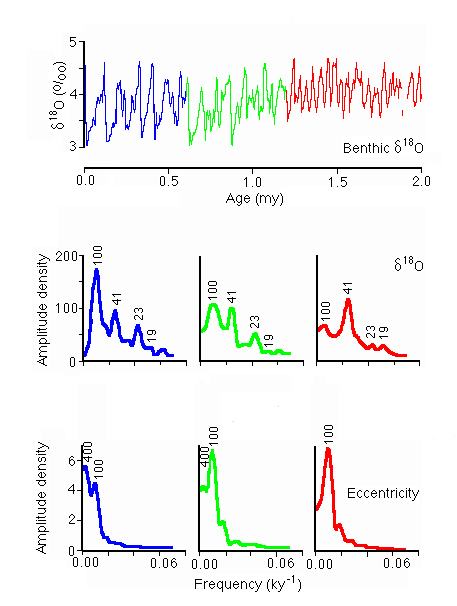
Figure GC-9. Benthic ![]() 18O
record for the past 2 my showing the increasing importance of the 100
ky frequency band. In contrast, the amplitude of the 100 ky
eccentricity signal declines over the same period.
18O
record for the past 2 my showing the increasing importance of the 100
ky frequency band. In contrast, the amplitude of the 100 ky
eccentricity signal declines over the same period.
4. The sequence of proxy phase leads and lags relative to ice
volume is the same for the 100 ky band as for the other two, but the
time delay between the early response group and ice volume
(![]() 18O)
is 15 ky rather than about 3 ky (Figure GC-3).
18O)
is 15 ky rather than about 3 ky (Figure GC-3).
5. Subtraction of the 23 and 41 ky contributions to the total
![]() 18O
record (Figure GC-10) leaves a residual that is very similar to the
100 ky band-pass filtered record.
18O
record (Figure GC-10) leaves a residual that is very similar to the
100 ky band-pass filtered record.
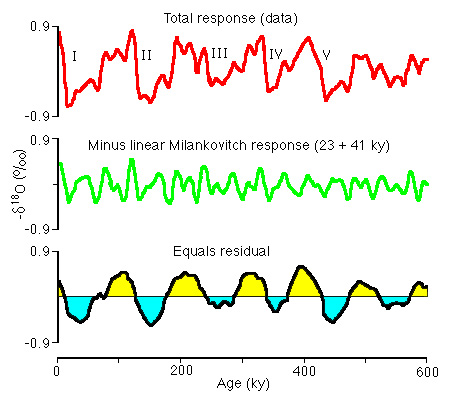
Figure GC-10. Residual ![]() 18O
signal after stripping the linear responses to precession and
tilt.
18O
signal after stripping the linear responses to precession and
tilt.
6. Models of icecap development without 100 ky forcing nevertheless develop free oscillations with periods in the 70-130 ky range.
In a recent paper, Shackleton (Science , v. 289, p. 1897, 2000) has compared 18O and CO2 in trapped air in the Vostok ice core with deep-sea 18O records. By independently tuning the ice and oceanic records to the Milankovitch tilt and precession cycles, he concludes that in the100 ky band, maximum NH summer radiation, deep water temperature, antarctic ice surface temperature (based on D/H ratio), and atmospheric CO2 are in phase (with 95% confidence), whereas ice volume lags by about 15 ky (Figure GC-11). This result throws no extra light on the link between eccentricity and the correlated proxy changes, however.
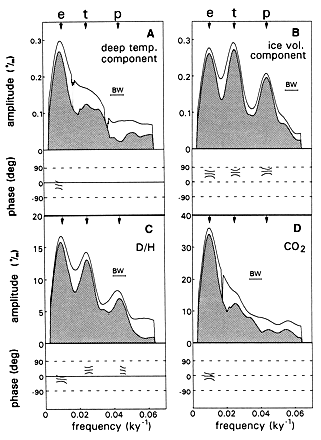
Figure GC-11. Amplitude, coherence, and phase spectra for deep-sea temperature (A), and ice volume (B) from deep sea sediments and for D/H (C) and CO2 (D) from the Vostok ice core relative to an eccentricity(e)-tilt(t)-precession(p) record that assigns roughly equal variance to each component and with the phase of midsummer Northern Hemisphere insolation. The solid line is the amplitude spectrum, the shaded area the coherence spectrum, and the phase spectrum (with 95% confidence limits) uses the convention that a positive angle is a phase lag (from Shackleton, op cit.)
From their observations, Imbrie et al. drew the following conclusions
1. Linear forcing by variations in incoming radiation due to eccentricity is not possible.
2. The similarity of the phase lag groupings of proxies in all three frequency bands suggests that the climate system operates similarly at all three periods, although with a longer delay between early responses and ice volume at 100 ky.
3. The similarity of the ice volume and eccentricity records in the 100 ky band is compatible with a resonance phenomenon in which "pacing" of the ice volume record by eccentricity phase locks the two records.
The model developed for the 23 and 41 ky responses (Figure GC-5) works for the 100 ky record (Figure GC-12), as long as the ice volume time constant is increased from 5 ky to 15 ky.
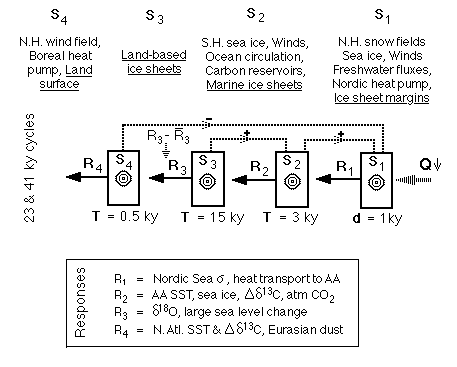
Figure GC-12. Imbrie et al. model for the 100 ky climate cycle compared to the 23/41 ky model (Figure GC-5). Note the longer response time for S3.
This led Imbrie et al. to suggest that the 100 ky climatic signal results from non-linear amplification of the incoming radiation signal (Figure GC-13) once an internal critical threshold is exceeded.
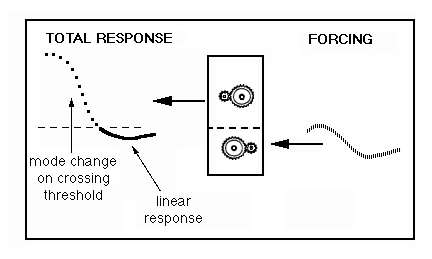
Figure GC-13. Conceptual model for climate where the response is linear until a threshold is crossed, after which the response is disproportionately amplified.
They suggest that this threshold is set by feedbacks (albedo, atmospheric circulation) that develop when northern hemisphere icecaps exceed a critical size which interferes with the re-establishment of the Nordic heat pump by radiation increases at the higher frequencies.
The system is paced by eccentricity because of its influence on the amplitude of the incoming radiation signal in the 23 ky band. The key appears to lie in the extension of the icecaps on to isostatically depressed continental shelves as the ice masses approach maximum size. Once this happens, even a small sea level rise (due to peak radiation at the precession frequency, for example) results in destabilization of the ice caps with rapid melting that leads to further destabilization. Such rapid collapses produce the "Terminations" which are such a prominent feature of the late Pleistocene ice volume record.
The detailed sequence of atmospheric, ice cap, and oceanographic events during the last two terminations (Figure GC-14, 15) is compatible with this concept.
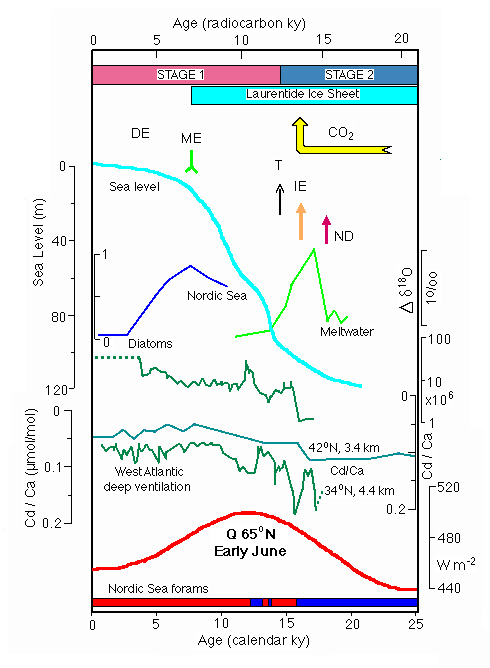
Figure GC-14. Sequence of events in the Nordic Sea - North
Atlantic region during Termination 1 (the transition from the last
ice age to the present interglacial). ND=major Nordic deglaciation
event, IE=increased exchange of Atlantic water, T=maximum temperature
rise, ME=maximum exchenge of Atlantic water, DE=decreased exchange of
Atlantic water, meltwater = Greenland Sea - global ![]() 18O.
18O.
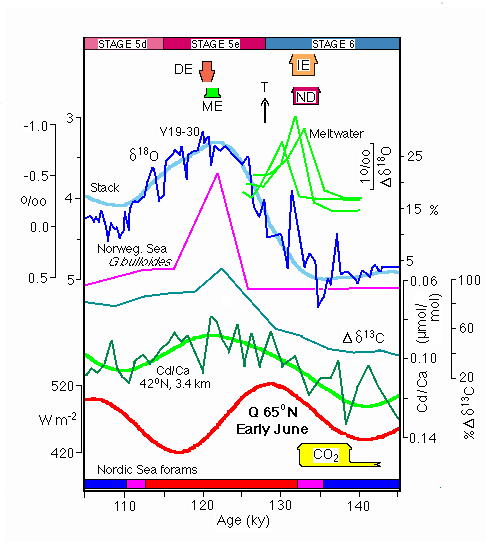
Figure GC-15. Sequence of events in the Nordic Sea - North Atlantic region during Termination 2 (the transition from the penultimate ice age to the last interglacial). Abbreviations as Figure GC-14. Note the age uncertainties (in CO2, ND, IE, purple sections in Nordic Sea forams) relative to Termination 1, which is well dated by 14C.
Recently, Maureen Raymo and her colleagues (e.g. Ridgwell et al ., 1999, Paleoceanography, v. 14, no. 4, pp.437-440) have suggested that low 65º N summer radiation peaks that occur every fourth or fifth precessional cycle lead to a build-up of "excess" ice on the icecaps, followed by rapid deglaciation during the next precessional peak. Time series analysis of a mixed 4+5 precessional cycle yields a 100ky spectral peak that resembles the SPECMAP 18O peak. Because the low summer radiation precession peaks result from modulation by eccentricity, such a 100 ky spectral peak will be in phase with eccentricity.
Still unexplained is the geologically rapid evolution of the 100
ky spectral peak in ![]() 18O
records compared to the 23 and particularly the 41 ky records which
have been relatively stable for the past two million years (Figure
GC-9).
18O
records compared to the 23 and particularly the 41 ky records which
have been relatively stable for the past two million years (Figure
GC-9).
Hypotheses to explain the increasing importance of the 100 ky cycle focus on modifications to the ice covered regions by a succession of glaciations. Examples include:
|
Oceanography 540 Pages |